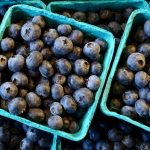Explainer: Types of blueberries

This information was posted by Oregon State University
Several types of blueberry are available as nursery plants through online catalogs or retail outlets. Not all types are suitable for your region. There are various cultivars within each type (see “Cultivars”).
- Northern highbush blueberry. Plants grow 6 to 7 feet high at maturity. All northern highbush cultivars are winter cold hardy for any region or microclimate in Oregon. Some frost damage may occur to growing parts, depending on the year and the region (see “Common problems”). While these cultivars will produce fruit with self-pollination, it is best to choose more than one cultivar; cross-pollination improves berry size and quantity. Each cultivar has a three- to five-week-long fruiting season. Cultivars differ in ripening time: early-season ( ‘Duke’ and ‘Spartan’); midseason (‘Bluecrop’ and ‘Liberty’) and late-season (‘Darrow’). In the Willamette Valley, ripe fruit is produced from late June–July, July–August, and August–September for early-, mid-, and late-season cultivars, respectively. While these cultivars ripen at different times, they all bloom at the same time. Any two cultivars enable good cross-pollination.
- Southern highbush blueberry. Plants grow to about 6 feet high at maturity. This type is not suitable for any region of Oregon. Southern highbush blueberry cultivars grow well here, but plants bloom in February in the Willamette Valley, leading to most or all of the flowers being lost to frost and no fruit. In southeastern, Central, and eastern Oregon, plants are not hardy enough to survive the winters. Unfortunately, some retail outlets in these regions do not distinguish between southern and northern highbush cultivars and sell both. Do your research before you buy. Commonly sold southern highbush cultivars include ‘Emerald’, ‘Jewel’, ‘San Joaquin’, ‘Star’, ‘Misty’, ‘O’Neal’, ‘Biloxi’, ‘Meadowlark’ and ‘Snowchaser’. Since this type is not adapted to Oregon, it is not included in Table 1.
- Northern and southern highbush blueberry hybrids. Plants grow 6 to 7 feet high at maturity. There is currently one hybrid cultivar, ‘Legacy’, that is available for home gardeners and is adapted to the Willamette Valley and southwestern Oregon. It is not cold-hardy enough to grow in southeastern, Central, or eastern Oregon. In these regions, gardeners won’t get a consistent crop from year to year; plants will likely lose flower buds to winter cold injury (see “Common problems”). While ‘Legacy’ will produce fruit with self-pollination, choose a northern highbush cultivar as a pollinator; cross-pollination improves berry size and quantity. ‘Legacy’ bushes produce up to double the fruit yield of northern highbush cultivars in adapted areas when they are managed well (see “Harvest”). Plants typically do not lose all their leaves in winter.
- Lowbush blueberry. Plants grow to about 1 foot tall. Lowbush blueberries (mainly V. angustifolium) are harvested from managed wild stands in Maine and eastern Canada. The fruit is frozen and sold throughout North America as “wild blueberries.” While some lowbush plants are sold in retail outlets (cultivars such as ‘Tophat’, ‘Brunswick’ and ‘Burgundy’), Oregon gardeners may find it difficult to achieve high yields for various reasons. Lowbush blueberries are not included in suggested cultivars.
- Northern highbush and lowbush blueberry hybrids (“half-highs”). Half-high cultivars were developed by crossing northern and lowbush blueberry species. Mature plants are 2 to 4 feet tall, depending on cultivar (see “Cultivars”). These are very cold hardy, especially as they are often covered with insulating snow in very cold regions. Yield and berry weight are considerably less than for northern highbush cultivars. These do not produce much fruit with self-pollination, so choose more than one half-high cultivar for cross-pollination. This type of blueberry is sometimes considered for container plantings or for planting in the landscape where there is insufficient space for a northern highbush cultivar.
- Rabbiteye blueberry. Plants grow up to 9 feet tall at maturity. This type of blueberry (V. virgatum) is native to the southeastern U.S. and is only adapted to the Willamette Valley and southwestern Oregon; the winters in other regions may be too cold for consistent fruit production. There are various blue-fruited cultivars available that ripen late in the Willamette Valley (August to late September). These do not produce fruit with self-pollination, so choose more than one rabbiteye cultivar for cross-pollination. While ‘Pink Lemonade’ is somewhat self-fertile and will produce berries if it’s the only rabbiteye cultivar in the yard, choose another rabbiteye cultivar to increase berry size and quantity.
- Ornamental blueberries. Plant height varies by cultivar. While all blueberry types and cultivars are attractive in the landscape, some have been specifically developed for this market. For example, ‘Sunshine Blue’ is a southern highbush blueberry noted for its pretty foliage. As with other southern highbush cultivars, it is not well-adapted for fruit production in these regions of Oregon. Regardless, you can expect nice foliage and some fruit in the landscape if pruned well (see “Pruning”). Other ornamental blueberry cultivars include ‘Jelly Bean’ and Peach Sorbet’. ‘Perpetua’, released by the cooperative breeding program in Oregon, has beautiful glossy foliage and produces two crops of fruit per season (Figure 5). While these are all beautiful ornamental cultivars, suited to the landscape, choose better-tasting and higher-yielding cultivars for fruit production.













































